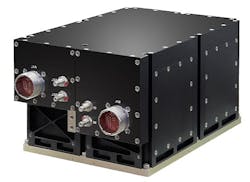The Lockheed Martin Space Systems segment in Sunnyvale, Calif., is prime contractor for the SBIRS satellite reconnaissance system. Company engineers have selected Northrop Grumman to provide its space inertial reference system for the fifth SBIRS geosynchronous Earth orbit satellite.
Northrop Grumman engineers will provide their company's Scalable Space Inertial Reference Unit (Scalable SIRU) for sensor pointing, stabilization, and attitude control on the SBIRS GEO-5 mission, Northrop Grumman officials announced this week.
Related: Northrop Grumman and Lockheed Martin complete SBIRS HEO-3 payload integration test
Northrop Grumman also has provided its Scalable SIRU for previous SBIRS GEO satellites, officials say. The SBIRS program delivers early warning of ballistic missile launches, missile defense, technical intelligence and battlespace awareness.
The SBIRS architecture features a mix of satellites in geosynchronous orbit, hosted payloads in elliptical orbit, and ground hardware and software. The Scalable SIRU also has been part of NASA's MESSENGER mission to orbit Mercury and the Global Precipitation Measurement mission.
At the heart of the Scalable SIRU is Northrop Grumman's patented hemispherical resonator gyro, which has been used in space without a mission failure for more than 28 million operating hours, Northrop Grumman officials say.
The Scalable SIRU combines innovation and high reliability – with 100 percent mission success in more than 26 million on-orbit hours and 147 billion miles traveled – for precision performance on space missions.
The hemispherical resonator Gyro (HRG) sensor on the Scalable SIRU is composed of three simple machined quartz parts -- an outer shell, a high-Q vibrating hemispherical resonator, and an inner shell.
The quartz construction of the HRG is inherently stable, impervious to aging effects, and naturally radiation hardened, Northrop Grumman officials say.
The navigation and guidance device is suitable for space applications because it is designed to operate in an evacuated hermetically sealed case. The device is appliable to Earth orbits at all altitudes and angles, interplanetary missions, and deep space missions.
Related: Lockheed Martin delivers new flight software architecture for SBIRS GEO spacecraft
The Scalable SIRU offers long life due to its simple HRG sensor design; ultra-low angle random walk and inherent freedom from dead band; a fault-tolerant and redundant architecture with cross-strapped HRGs and electronics; an inertially stable, low noise, wide bandwidth reference; and rad-hard sensors and electronics.
For more information contact Northrop Grumman Electronic Systems online at www.northropgrumman.com, or Lockheed Martin Space Systems at www.lockheedmartin.com/us/ssc.



